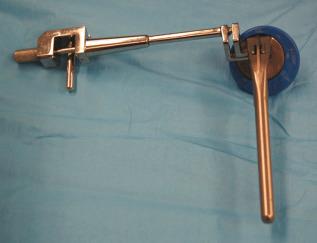Physical Address
304 North Cardinal St.
Dorchester Center, MA 02124
Humeral prosthetic positioning remains the most difficult step in performing unconstrained humeral head arthroplasty or reverse shoulder arthroplasty for fracture. Placing the humeral component excessively proud or in excessive retroversion may result in loss of fixation and subsequent migration of the greater tuberosity ( Figs. 29.1 and 29.2 ). The complication of tuberosity migration has been found to be a key factor in poor results after unconstrained shoulder arthroplasty performed for the treatment of proximal humeral fractures. Tuberosity healing appears to be less critical for reverse shoulder arthroplasty for fracture but is important nonetheless. Tuberosity healing in reverse shoulder arthroplasty can improve functional results and improve stability. This chapter details humeral prosthetic positioning for both unconstrained and reverse shoulder arthroplasty.
After control of both tuberosities has been achieved, the humeral shaft is identified. The humeral shaft is progressively reamed until the reamer that is used corresponds to the diameter of the prosthesis to be implanted ( Fig. 29.3 ). Using the largest diaphyseal reamer that is possible to advance down the humeral canal without difficulty avoids selecting too small a diameter of the humeral implant, which can inadvertently be positioned in valgus or varus ( Fig. 29.4 ). However, because most of these patients are severely osteopenic, no effort is made to force too large a reamer down the humeral canal for fear of iatrogenic fracture. The bicipital groove is located and two 2-mm holes are drilled in the humeral shaft approximately 1 cm distal to the fracture site, one on each side of the bicipital groove, for use later in tuberosity fixation ( Fig. 29.5 ). The intraarticular portion of the long head of the biceps, which is frequently at least partially torn, is excised, and suture tenodesis of the remaining stump to the pectoralis major tendon is carried out with no. 1 nonabsorbable braided suture in a figure-of-eight stitch as described in Chapter 5 .



The trial humeral implant is then assembled by selecting a stem with a diameter corresponding to the largest diaphyseal reamer used and a head size corresponding to the size of the removed head fracture fragment. The humeral head fragment is usually slightly ovoid and has a lesser and greater diameter. A head size corresponding to the lesser diameter is selected to avoid insertion of too large a component, which can lead to nonunion of the tuberosities ( Fig. 29.6 ). The prosthetic system that we use allows variation of the posterior and medial offset of the humeral head seen in normal anatomy. We have found it most useful to place the offset laterally at the “1” position because this has consistently given us the most nearly anatomic reconstruction radiographically ( Fig. 29.7 ). The trial implant is attached to the prosthetic holder ( Fig. 29.8 ).



Become a Clinical Tree membership for Full access and enjoy Unlimited articles
If you are a member. Log in here